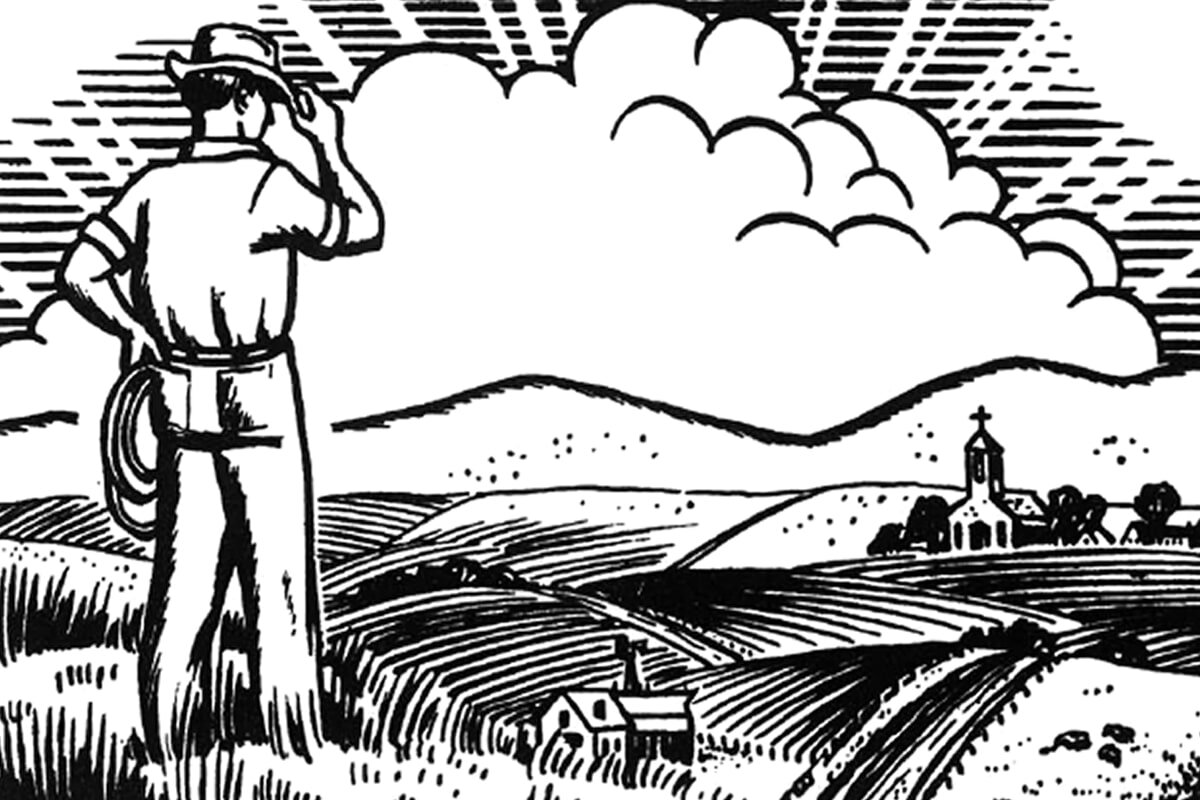O Blessed Lady of the Fields
“The spinal cord of the country” was Pope Pius XII’s magnificent metaphor of rural life, a sentiment shared by his predecessor Pius VII, who, in 1802 wrote, “Agriculture is the first and most important of all arts; so it is also the first and true riches of states.”[note]Luigi G. Ligutti, "The Popes and Agriculture," in Commonweal Magazine (March 1, 1940).[/note] This common theme of agricultural wealth repeated throughout the social doctrine of the Church is preserved today. In 2011, Pope Emeritus Benedict XVI reflected on the inestimable spiritual and economic value of small family farms, reminding lay Catholics and clergy of the importance of preserving rural communities, good stewardship principles and their rootedness in the faith.In 1923, Bishop Edwin O’Hara broke ground with the founding of the National Catholic Rural Life Conference (recently re-branded “Catholic Rural Life” or CRL), a leader in nurturing the interests of small farm ownership, rural life, and the rural church. Originally headquartered in Des Moines, Iowa,[note]Today CRL is based out of the University of St. Thomas in St. Paul, Minnesota.[/note] the Catholic Rural Life’s mission is simple: to apply the teachings of Christ to rural lands and to become a player in policy reforms aimed at benefitting farming culture. But it is a mistake to peg CRL as a fish in a sea of public policy think tanks. From its very foundation the organization’s cornerstone was chiseled to bring “Christ to country, the country to Christ!” and anchor the spiritual life in the hearts of labor on God’s green earth.21 years later, the Jesuit Fr. Alban J. Dachauer was recruited to organize a prayer book published under the title With the Blessings of the Church—literally, a book granted special permissions by Pius XII to translate the published collection of prayers and blessings from their original Latin to English. A Wisconsin native, Dachauer was freshly ordained with a gift for modern languages, a talent that earned him a post at Creighton University in his later years.[note]Obituary of Father Alban J. Dachauer, SJ, The Milwaukee Journal (September 13, 1972).[/note]Over a decade after its original publication, the conference expanded the book and gave it an updated title: The Rural Life Prayerbook, a devotional to encourage sacramental life and connect family prayer with the rural life movement. In a letter addressed to Msgr. Luigi Ligutti, dated 1958, Alfredo Cardinal Ottaviani, Prefect of the Congregation for the Faith, highly praised the volume of traditional prayers, most of which originated in the Ritual Romanum.[note]Michael J. Woods, Cultivating Soil and Soul: Twentieth-Century Catholic Agrarians Embrace the Liturgical Movement (Minnesota : Liturgical Press, 2009).[/note]Included in the book are the makings of what Bishop O’Hara called a rural apostolate or movement, one which reaches beyond the confines of rural life and extends to the appreciation often found today in urban gardening and farming.Starting with the Ordinary of the Mass, the table of contents boasts an impressive directory of seasonal prayers and feasts. Among them are prayers to Ss. Joseph and Patrick, family consecration to the Sacred Heart of Jesus, dedication to the Divine Majesty, a prayer to Christ the King, and a long selection of rote prayers. There are thanksgiving prayers, novenas, and supplications in times of economic hardship or debt. Equally gratifying are the blessings. They are a feast for the eyes: the blessing of cheese or butter, of wine on the Feast of St. John, seeds and crops, wells, the setting of crosses in fields, and bacon:
Bless, Lord, this bacon which You have made, that it may be a healthful food for mankind. Grant by the invocation of Your Holy Name that all who partake of it may receive health of body and safety of soul, through Christ our Lord. Amen.
The bacon is then sprinkled with holy water.No rural book of prayers is complete without devotions to Saint Isidore “the laborer,” patron saint of farmers. Not to be confused with St. Isidore of Seville, San Isidro Labrador was a plowman and farmer born in 11th century Spain. His canonization in 1622 by Pope Gregory XV took place along with other notable saints: Philip Neri, Teresa of Jesus, Ignatius of Loyola, and Francis Xavier. The 416 pages in The Rural Life Prayerbook are wrapped in beautiful binding, decorated with red-edged pages, and come with green and red ribbon markers. All of the original illustrations by Tom Chouteau—student of the late priest—calligrapher Fr. Edward Catich—have been preserved. This handsome prayer book should be of great interest to distributists for the essential devotions that are at the heart of agrarian life. Catholic Rural Life and TAN Books should be commended for this fine reproduction. We pray it may serve our farmers and rural families, and reignite agrarians with the fire of the gospels.
The 416 pages in The Rural Life Prayerbook are wrapped in beautiful binding, decorated with red-edged pages, and come with green and red ribbon markers. All of the original illustrations by Tom Chouteau—student of the late priest—calligrapher Fr. Edward Catich—have been preserved. This handsome prayer book should be of great interest to distributists for the essential devotions that are at the heart of agrarian life. Catholic Rural Life and TAN Books should be commended for this fine reproduction. We pray it may serve our farmers and rural families, and reignite agrarians with the fire of the gospels.
We will regard our land as God’s land; as stewards of His bounty we will conserve and improve it so that it will increasingly continue to give glory to Him.
To order the book, please visit Saint Benedict Press/TAN Books.

